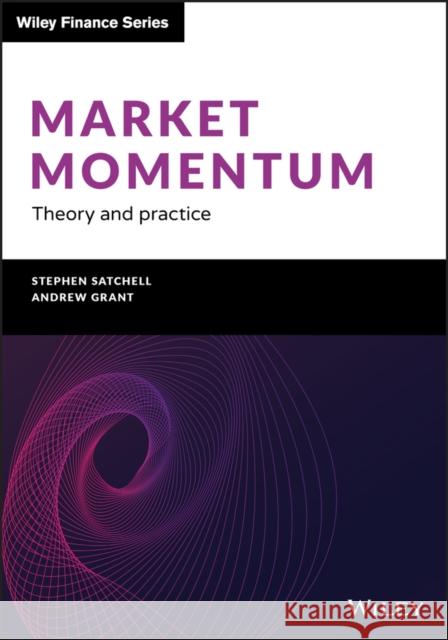Market Momentum: Theory and Practice » książka



Market Momentum: Theory and Practice
ISBN-13: 9781119599326 / Angielski / Twarda / 2020 / 432 str.
Market Momentum: Theory and Practice
ISBN-13: 9781119599326 / Angielski / Twarda / 2020 / 432 str.
(netto: 292,80 VAT: 5%)
Najniższa cena z 30 dni: 304,92
ok. 30 dni roboczych.
Darmowa dostawa!
Contributors xvii Introduction xxiii Chapter 1 Behavioural Finance and Momentum 1 1.1 Introduction 1 1.2 The failure of risk-based explanations 3 1.3 Behavioural models of momentum 3 1.4 Slow information diffusion 5 1.5 Patterns in information arrival 6 1.6 The 52-week high and capital gains overhang 8 1.7 Institutional trading and momentum profits 10 1.8 Sentiment and momentum 11 1.9 Discussion 12 Chapter 2 A Taxonomy of Momentum Strategies 16 2.1 Introduction 16 2.2 Relative strength strategies 17 2.3 Time-series momentum strategies 18 2.4 Cross-sectional momentum strategies 20 2.5 Cross-asset momentum 27 Chapter 3 Demystifying Time-Series Momentum Strategies: Volatility Estimators, Trading Rules and Pairwise Correlations 30 3.1 Data Description 34 3.2 Methodology 39 3.3 Turnover Reduction 42 3.4 The Recent Underperformance of Time-series Momentum Strategies and the Effect of Pairwise Correlations 52 3.5 Trading Costs Implications 58 3.6 Concluding Remarks 63 Chapter 4 Risk and Return of Momentum in Developed Equity Markets 68 4.1 Introduction 68 4.2 Definition of momentum 69 4.3 Simple factor portfolios 71 4.4 Multifactor structure 73 4.5 Pure factor portfolios 75 4.6 Empirical results: momentum performance 76 4.7 Empirical results: momentum risk 80 4.8 Diversification benefits 83 4.9 Summary 84 Chapter 5 Momentum Across Asset Classes 86 5.1 Measuring momentum 87 5.2 Framework: equity momentum and corporate credit risk 87 5.3 Empirical studies: momentum and credit risk 89 5.4 Our research on equity momentum and bond returns 91 5.5 Geographically bound assets 92 5.6 Momentum in other illiquid assets 94 5.7 Cross-asset class effects of commodities 95 5.8 Momentum effects and taxable investors 95 5.9 Active management and momentum effects 96 5.10 Conclusions 98 Chapter 6 Momentum in Momentum ETFs 103 6.1 Introduction 103 6.2 Why are momentum ETFs so popular? 104 6.3 What is in a momentum ETF? 112 6.4 Which factors drive active risk for momentum ETFs? 114 6.5 From constrained to unconstrained strategies 117 6.6 Conclusions 119 Chapter 7 CTA Momentum 120 7.1 Introduction 120 7.2 Time-series momentum (TSM) 121 7.3 Strategy return models 127 7.4 Time-series momentum 131 7.5 TSM meets CSM with two instruments 133 7.6 Conclusions 135 7.A.1 Appendix A: Correlation parameter restrictions 136 7.A.2 Appendix B: Proofs of variances and covariance 138 Chapter 8 Overreaction and Faint Praise - Short-Term Momentum in Contemporary Art 141 8.1 Introduction 141 8.2 Contemporary art market ecosystem 144 8.3 ArtForecaster data 145 8.4 Systematic forecasting strategies 149 8.5 Conclusions 157 Chapter 9 Volatility-Managed Momentum 160 9.1 Introduction 160 9.2 Data and momentum portfolio construction 161 9.3 Volatility-managed momentum strategies 162 9.4 Some potential practical issues 166 9.5 The best volatility measure for momentum? 170 9.6 Concluding remarks 172 Chapter 10 Theoretical Analysis of the Fama-French Portfolios 174 10.1 Introduction 174 10.2 Strategies, notation and preliminaries 179 10.3 Distribution of Fama-French factors 182 10.4 Fama-French factors with sequential sorting 189 10.5 Conclusion 194 10.A.1 Proof of Lemma 1 194 10.A.2 Proof of Theorem 3 195 10.A.3 Proof of Theorem 4 196 Chapter 11 Exploiting the Countercyclical Properties of Momentum and other Factor Premia - A Cross-Country Perspective 199 11.1 Introduction 199 11.2 Methodology 200 11.3 Alternative investment strategies 206 11.4 Quantifying the utility of risk premia strategies 211 11.5 Summary and conclusions 215 Chapter 12 Time-Series Variation in Factor Premia: The Influence of the Business Cycle 218 12.1 Introduction 218 12.2 Factors and factor rotation 219 12.3 Factors and the business cycle 220 12.4 Data and summary statistics 222 12.5 Empirical results 224 12.6 Conclusions 234 12.A.1 Derivation of cash-flow news series 234 12.A.2 US leading economic indicator and global risk appetite indicator 236 12.A.3 Dynamic multifactor strategy: extension to other market segments and regions 236 Chapter 13 Where Goes Momentum? 243 13.1 Introduction 243 13.2 Momentum strategies 245 13.3 Data 246 13.4 Method 247 13.5 Results 252 13.6 Risk-adjusted after-transaction costs performance of time-series and cross-sectional momentum strategies 260 13.7 Conclusions 269 Chapter 14 Time-Series Momentum in Credit: Machine Learning Approach 273 14.1 Introduction 273 14.2 The philosophy of artificial intelligence 274 14.3 Vanilla time-series momentum 277 14.4 Generalized linear models (GLM) - Lasso, Ridge and Elastic Net 280 14.5 Determining optimal hyper-parameters via cross-validation 283 14.6 Results: generalized linear models 284 14.7 Random forests 284 14.8 Neural networks 289 14.9 Results and comments 291 14.10 Conclusion 293 Chapter 15 Momentum and Business Cycles 297 15.1 Introduction 297 15.2 Momentum, business cycles and realised market return 298 15.3 Momentum and expected market risk premiums 301 15.4 Momentum, overconfidence and sentiment 309 15.5 Summary and conclusions 311 Chapter 16 Momentum as a Fundamental Risk Factor 314 16.1 Introduction 314 16.2 Defining momentum as a strategy 316 16.3 A new framework 318 16.4 From realised returns to forecast returns 319 16.5 Examining behaviour 319 16.6 The momentum trader as a bystander 323 16.7 Extending the model 325 16.8 Short-term versus long-term investors 326 16.9 The impact of the short-term investor 330 16.10 The momentum risk premium 332 16.11 The Apollo asset pricing model 334 16.12 Momentum alpha 335 16.13 Beta momentum 339 16.14 Beta signal 340 16.15 Momentum strategies 341 16.16 Results 347 16.17 Analysis of results 353 16.18 Conclusions 355 Chapter 17 Momentum, Value and Carry Commodity Factors for Multi-Asset Portfolios 359 17.1 Introduction 359 17.2 Methodology and key research questions 361 17.3 Commodity factors - insights from the historical data 362 17.4 Wealth accumulation strategies and rebalancing considerations 366 17.5 Wealth decumulation strategies 373 17.6 Long/short versus long only strategies 375 17.7 Completion portfolios versus maximum Sharpe ratio portfolios 379 17.8 Conclusions 380 17.A.1 Momentum factor 381 17.A.2 Carry factor 381 17.A.3 Value factor 382 17.A.4 From commodity factors to factor portfolios 383 17.A.5 Factor construction 383 Index 387
1997-2026 DolnySlask.com Agencja Internetowa
KrainaKsiazek.PL - Księgarnia Internetowa









